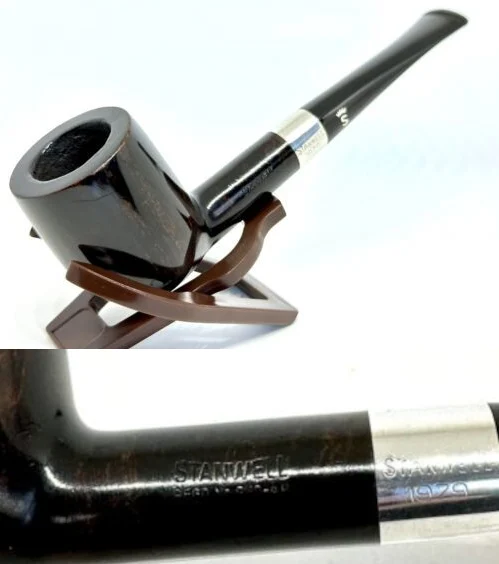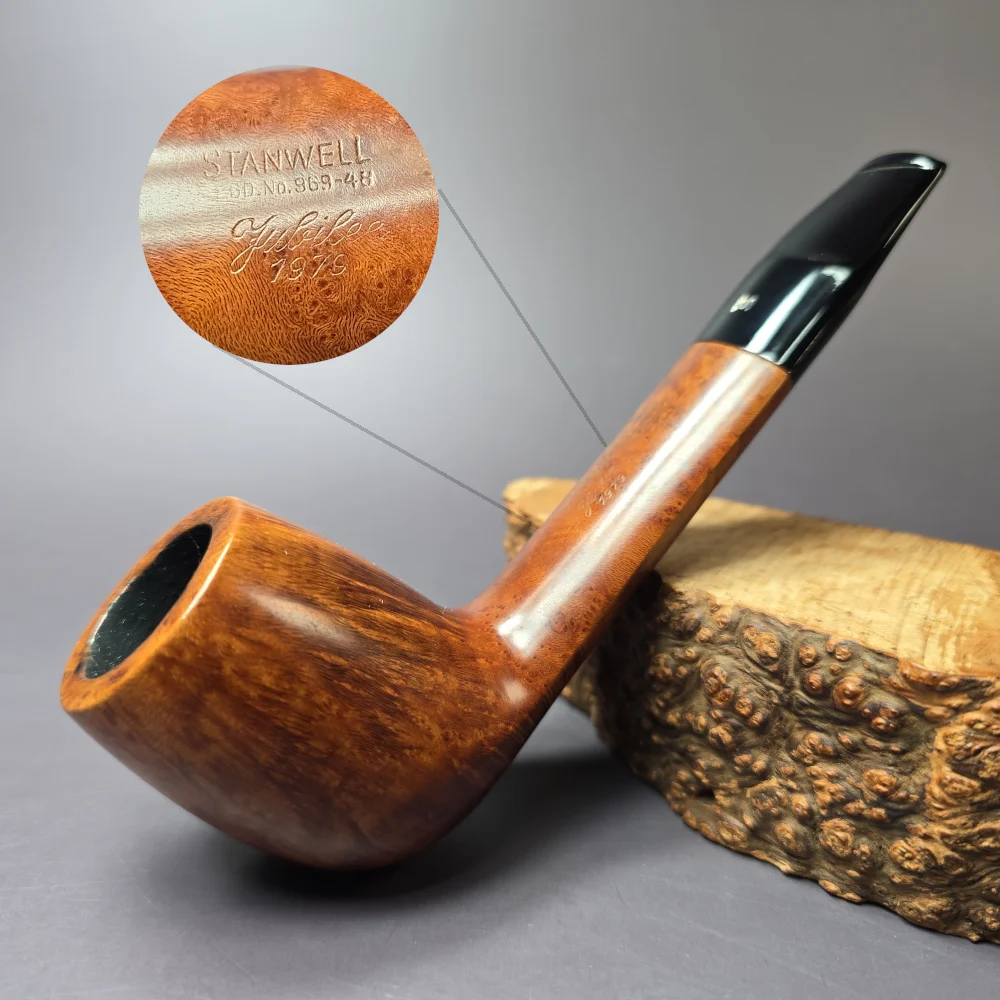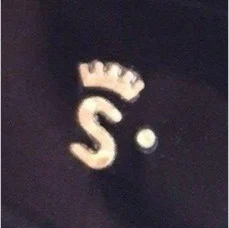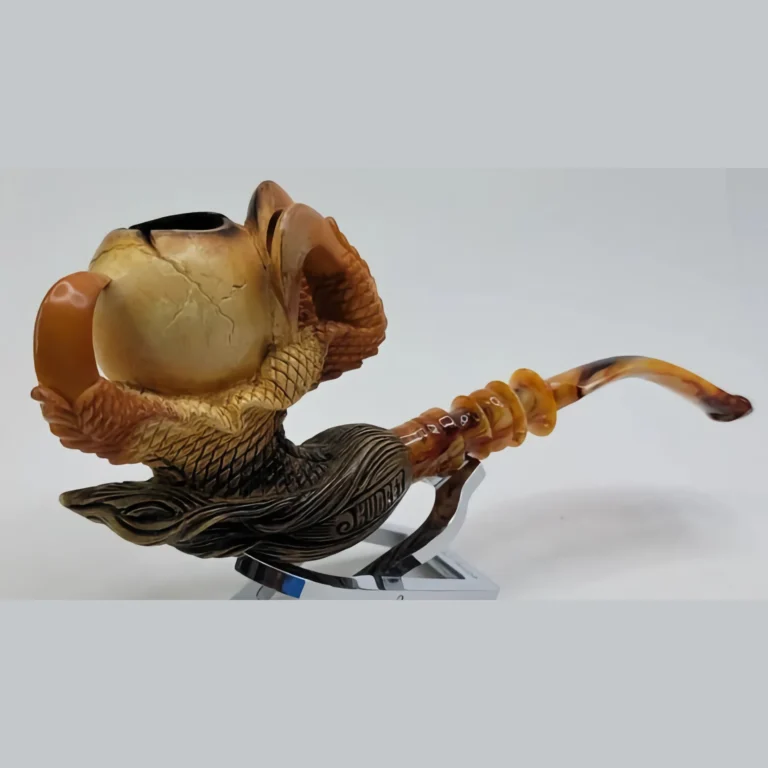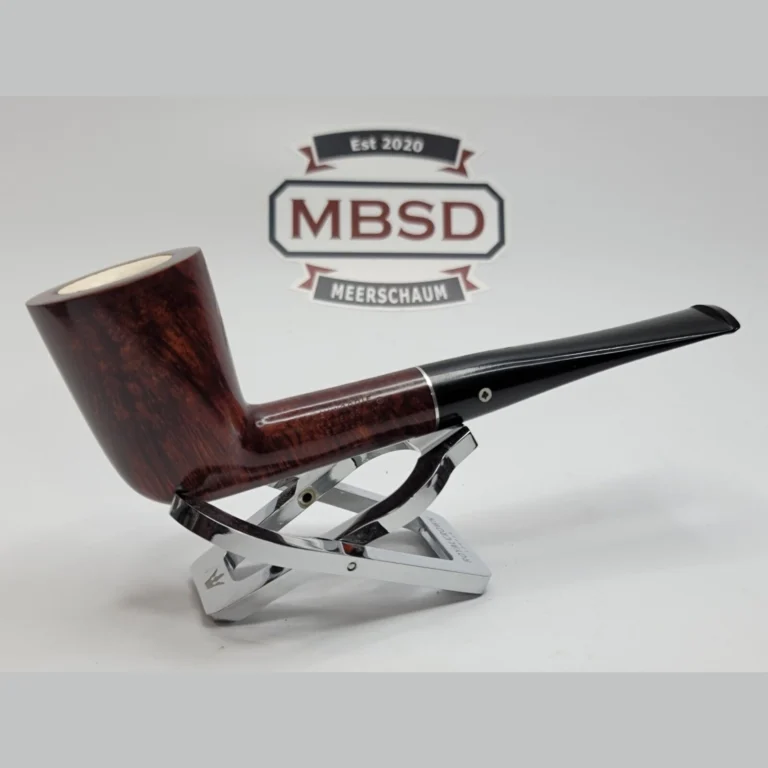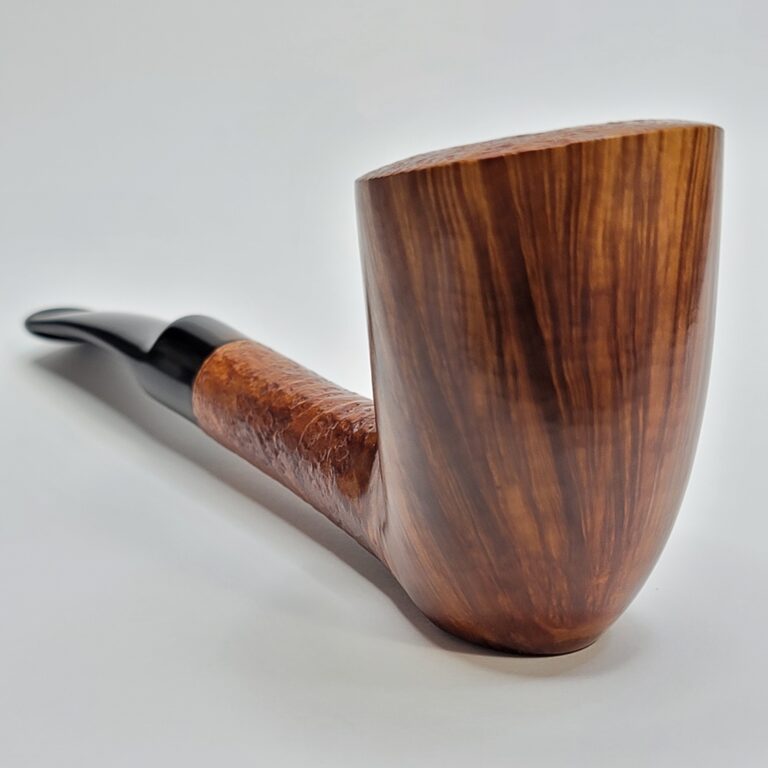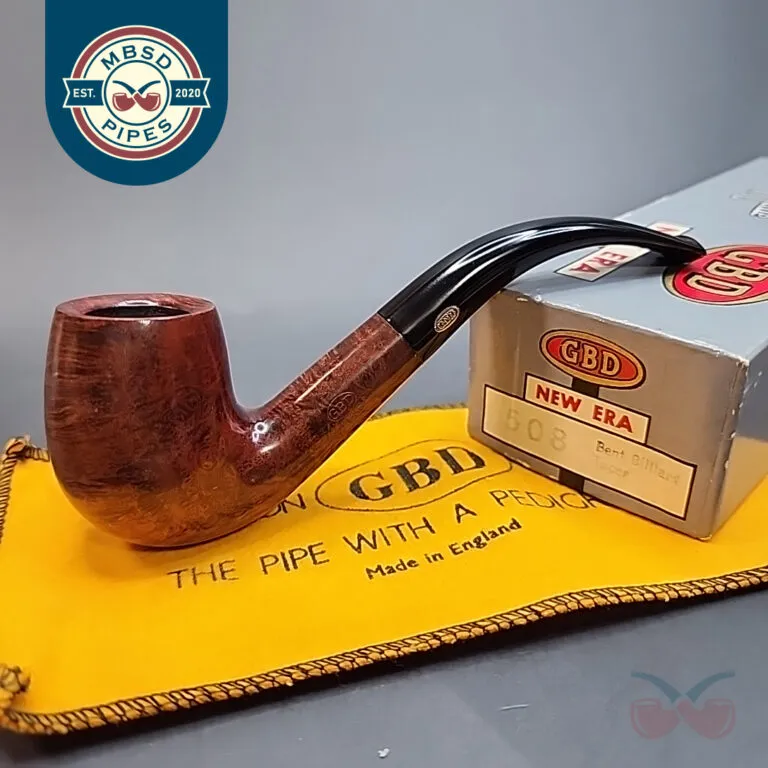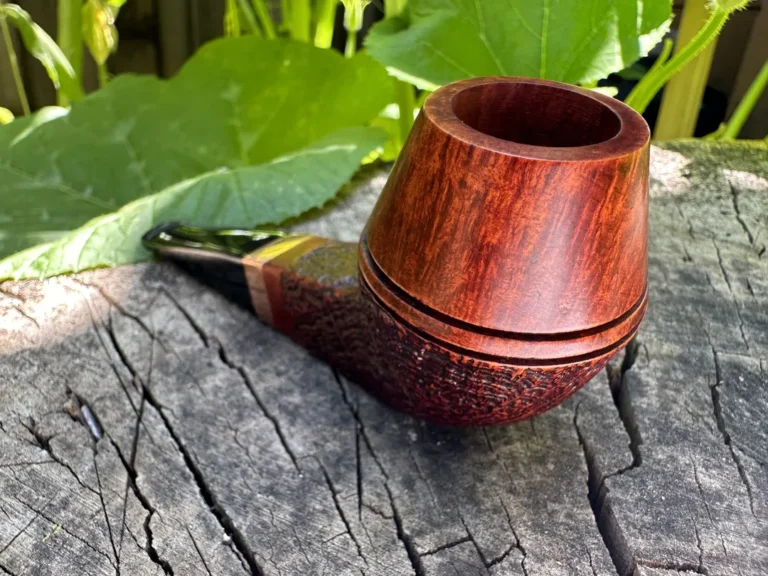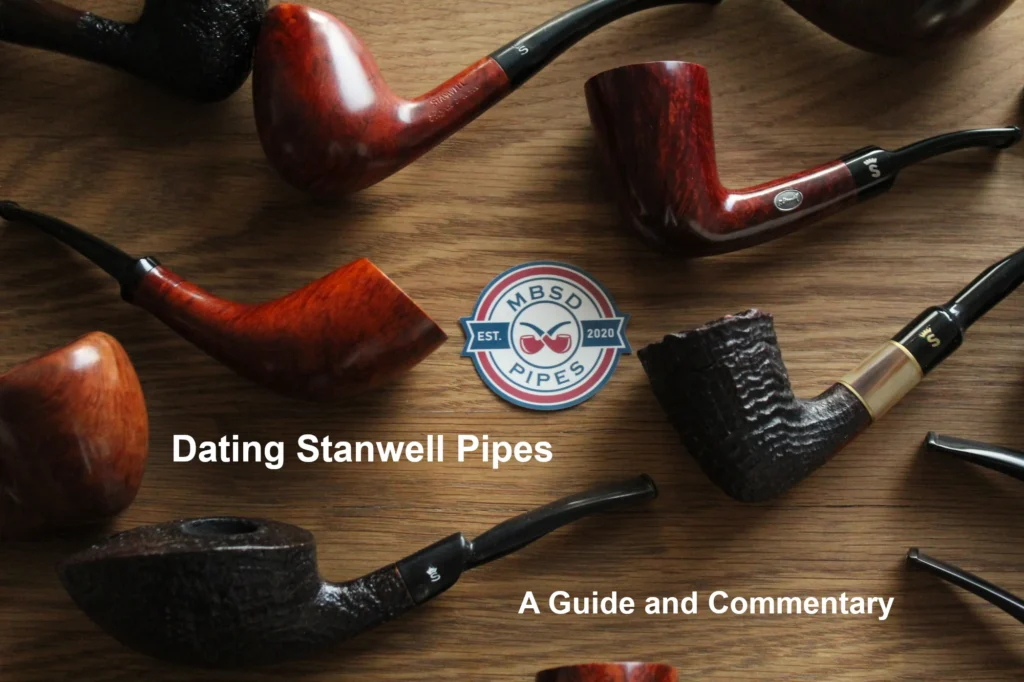
To see our currently available Stanwell pipes, click here.
Stanwell is one of the most popular contemporary pipe-manufacturers, as well as being the oldest Danish-owned manufacturer still in operation at the time of writing (2024). As a result, Stanwell is one of the most common makes found on the contemporary estates market. If you’ve encountered someone selling a Stanwell estate pipe before, chances are that the pipe has been categorized in some way that indicates its provenance. Sometimes, a Stanwell will be labelled as being from the make’s ‘Reg. Era,’ or ‘Registration Era.’ Sometimes, a Stanwell will be attributed to a certain individual, such as Sixten Ivarsson or Tom Eltang (what these attributions mean will be covered in a subsequent article). And, sometimes, a Stanwell may be labelled as ‘Danish made.’
For those who do not know much about Stanwell pipes, these extra bits of information can be confusing. Even for those who know plenty about these pipes, it is easy to make mistakes, as much of the history of Stanwell pipes is still not explicitly documented. Furthermore, unlike other historic pipemakes, there is much less of a unified consensus over which aspects of any particular Stanwell pipe matter, and which aspects don’t. Consequently, different estates sellers differentiate Stanwell pipes differently.
At MBSD pipes, we regularly sell Stanwell estate pipes and, like any estates seller, we have our own preferences for how to describe and distinguish the Stanwells that we sell. We also like to be transparent about how we evaluate and price our pipes. As dating plays a significant role in this evaluation and pricing, we asked friend of the store James to write something to help our buyers understand this process. Here he will only be covering main-brand Stanwells, but we hope to return to the topic to cover Stanwell’s many sub-brands, such as Danish Sovereign and Danske Club, in the near future.
Note: those who wish to read about the finer details of dating Stanwell pipes may find the whole of this article interesting. Those who would prefer a quick primer on dating Stanwells just as we do may skip ahead to the section on ‘A Revised Dating System for Stanwell Pipes’ in the contents table below.
Pipes That Can be Dated to a Specific Year of Manufacture
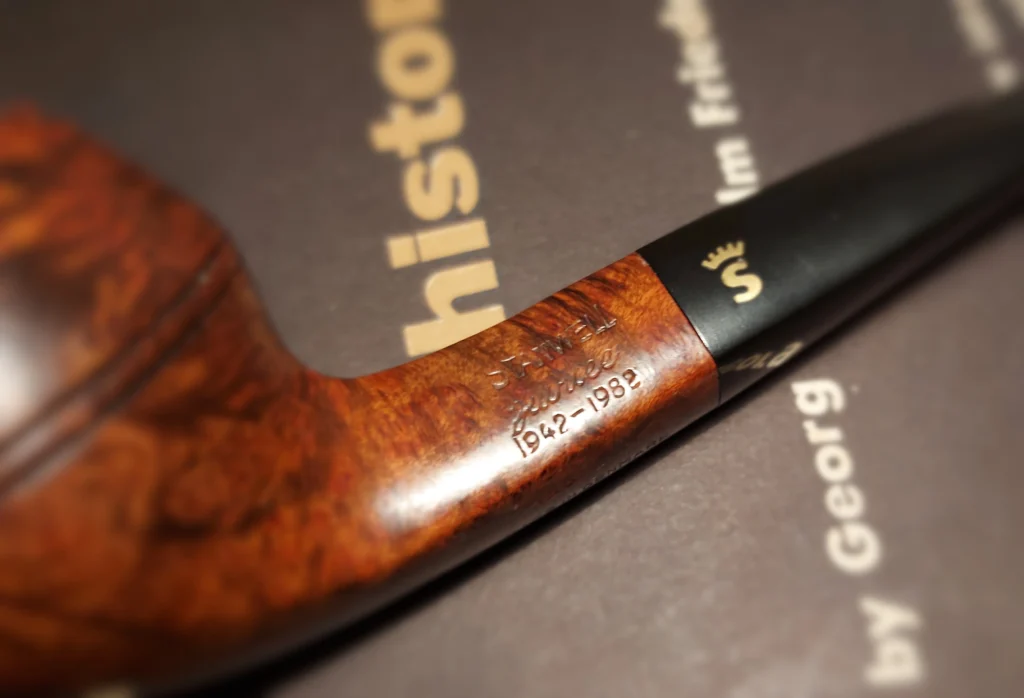
Certain Stanwell pipes can be dated to the exact year they were manufactured (or, at least, to the year they were distributed for sale). The reason for this is that these pipes have their year of manufacture written somewhere on the pipe, whether in the stamping on the bowl, or engraved into the pipe’s silverwork. These pipes fall under several, relatively stable categories: Pipes of the Year, competition pipes, ‘Xmas’ (Christmas) pipes, ‘Jubilee’ (or, in Danish, Jubilæum) and Anniversary pipes, and pipes released to mark local or national events. Pipes of the Year and Xmas pipes are simple to understand, as Stanwell is far from the only make to release such pipes annually. Competition pipes are pipes made for slow-smoking competitions, and usually feature an extra stamp indicating which competition they were made for, such as the Danish Championship (Danish: Danmarks mesterskab), which is stamped, ‘DM’.). Jubilee and Anniversary pipes have been released by Stanwell to celebrate milestones in the make’s history, such as its 40th anniversary in 1982, or its 75th anniversary in 2017. Event pipes are a little broader in scope, from pipes and tobaccos exhibitions to the Olympics, but they are nonetheless tied to a single year in some manner or another.
Dating these pipes is relatively easy:
- Both the standard and German-market Pipes of the Year have that year on the pipe, typically (though not always) engraved in silverwork.
- Competition and Xmas pipes also have the year of the competition stamped as part of their bowl nomenclature. Competition pipes are also stamped with an indicator of which one they were for, such as ‘DM’ for the Danmarks mesterskab (English: “Danish Championship”) competition.
- Jubilee pipes from 1982 onward have as part of their nomenclature the length of time being celebrated, such as ‘1942-1982’ (Stanwell backdates their anniversaries to the year its founder, Poul Nielsen, first began making pipes, however ‘Stanwell’ as a make was technically not founded until around 1945, and not registered as a trademark until 1948). In these cases, the latter year is the year the pipe was made.
- Stanwell commemorated its 65th (2007) anniversary with a two pipe set, one made from briar, and the other made from beech wood, both straight bulldogs. These pipes are not stamped with the year of manufacture, but their presentation case is; if no case is available, the pipes bear the distinct bowl nomenclature, ‘STANWELL/MADE IN DENMARK/No. 1’ (on the briar) and ‘KRYINGE/MADE IN DENMARK/No. 1’ (on the beech), making them nevertheless identifiable.
- Stanwell commemorated its 75th (2017) anniversary with a set of pipes, each of which came with a leather case. These pipes were not stamped with the year of their manufacture, but are identifiable due to the distinct engraving on the silver collar each wears, which of a horse and carriage (in the style of one of Stanwell’s early trademarks).
- Finally, there are more miscellaneous Stanwells which usually have a year marked somewhere on them to commemorate other events, though there are exceptions that require further research to pin them down. This research tends to need to be oriented towards the event itself, rather than towards Stanwell, however.
Pipes That Can be Dated to a Specific Period of Manufacture: An Introduction
For other Stanwell pipes, dating becomes more complicated and less precise, as, unlike some other makes, standard-production Stanwells are not stamped with a date of manufacture. Nevertheless, Stanwell pipes are commonly divided into distinct periods of manufacture, with the most detailed approach dividing them into one of four periods, or ‘eras’:
- 1948 – 1970;
- 1970 – late 1990s;
- late 1990s – 2009, and;
- 2010 – present.
There are issues with this periodization, which we will turn to soon, but for now, what is worth keeping in mind is that the reasoning used to bracket its eras is different for each one. As we shall see, the reasons that a 1960s pipe is differentiated from a 1980s pipe are not the same reasons that a 1980s pipe is differentiated from a 2000s pipe; likewise, the reasons that a 2000s pipe is differentiated from a 2020s pipe are not the same reasons as either of the former. Unlike certain English or American makes, it is not simply the case that the manufacture of Stanwell pipes can be divided up based on who owned the company, how the pipes were made, or who made them – and when. We might therefore wonder why Stanwell pipes are divided into the eras they are, or why other periodizations are not observed. We might also wonder if the eras commonly observed reflect genuinely significant differences between the pipes that belong to those eras.
Comoy’s collectors, for example, often prefer pipes made prior to 1980, after which the make was absorbed by Cadogan Investments. These collectors maintain that the quality of Comoy’s pipes subsequently decreased due to Cadogan’s handling of Comoy’s production. Some Dunhill collectors similarly prefer certain eras over others, such as those produced during the mid-1950s to mid-1960s. But, in this case, this is partly because Dunhill is said to have stopped oil curing their bowls in the late 1960s, which is believed to have impacted the smoking properties of Dunhill pipes. As we discussed in our Barling guide, the Barling family made the briar pipes to which they gave their name from the early 20th century to the early 1960s, after which they were dismissed and other pipe-makers were hired in their place.
‘Pre-’ and ‘Post-Cadogan’ Comoys, 1960s and 1970s Dunhills, and ‘Family era’ and ‘Corporate era’ Barlings are considered distinguishable in their aesthetic and functional qualities, and these distinctions map neatly onto these pipes in either their stamping or nomenclature. But what about Stanwells? Are there really ‘eras’ in Stanwell’s production history that translate into significantly different pipes and smoking experiences? This is not an easy question to answer. The least controversial thing we could say is that, as with many things in life, the divisions employed in the dating of Stanwell pipes are an inseparable mixture of what is true, what is valued, and what is practical.
‘Eras’ Approaches
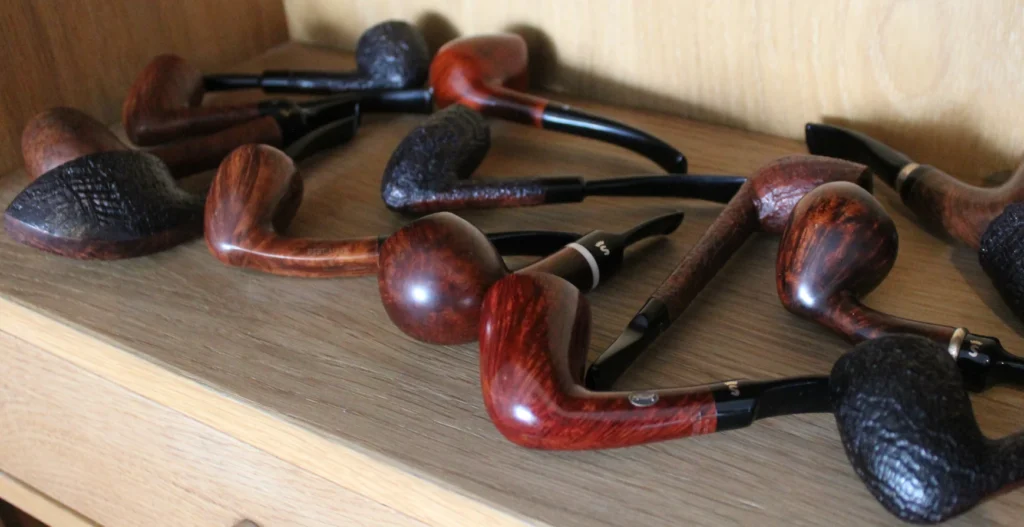
Imagine you find yourself with a box filled with Stanwell pipes, none of which have their original packaging or purchase records. As Stanwell themselves will tell you, they’ve been making pipes for over 75 years, which means they have made a lot of pipes. If you were to try to sort this box of pipes so that you know the pipes you have, you’ll find that they’re all different from each other in some way. The design of each pipe will be different, and the style of design may be very different too; some will be traditionally shaped and not unlike the pipes of Dunhill or Comoy’s, while others will be a shape that is unique and harder to compare with those typically offered by similarly long-established makes. The most visible identifier of your Stanwells, the ‘S’ logo on their stems, will also frequently be different from pipe to pipe. Some pipes will have a simple, thin, white ‘S,’ others will have this same ‘S,’ but with a white crown. Some pipes will have a silver crowned ‘S’ that is much bolder and thicker, while other pipes will have the same logo, but golden rather than silver. Within these four most recognizable varieties of stem logos, there will be even further variations noticeable upon closer inspection, such as in thickness, hue, depth, and so on.
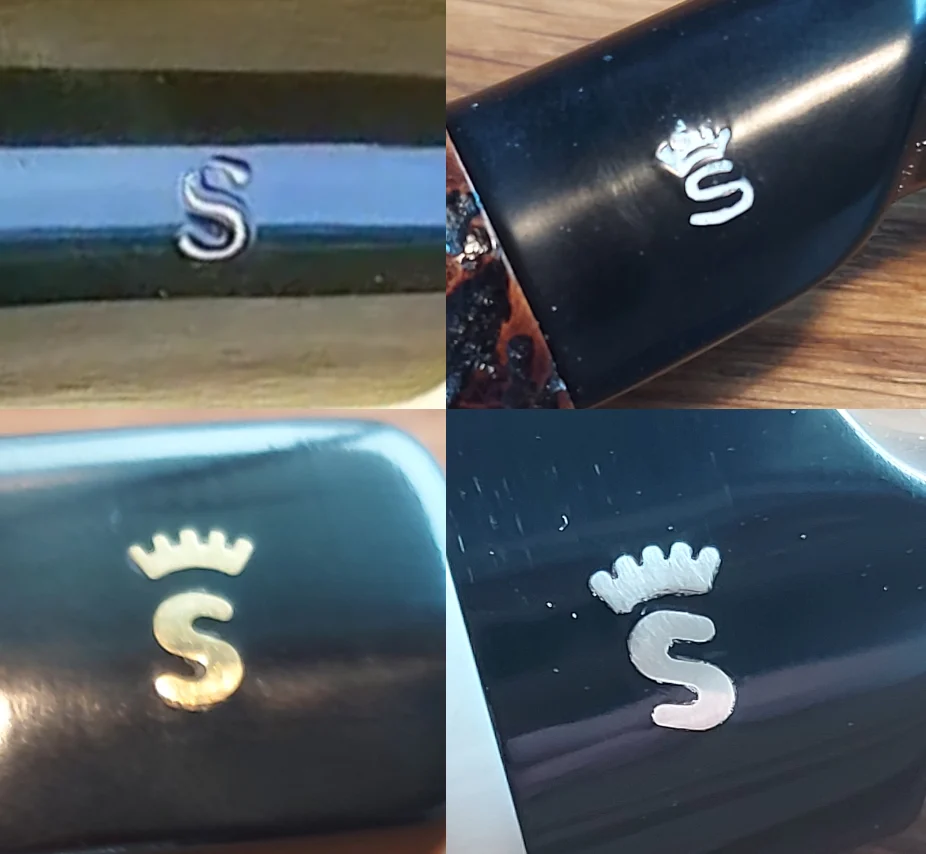
Both of these things set Stanwell pipes apart from one another, but tying them to even a loose dating scheme is difficult. Using the various catalogs that Stanwell collectors have graciously scanned, we can have some idea of the years in which certain shapes and series were available to purchase. But not all of Stanwell’s shapes – of which there have been hundreds – can be found in these catalogs. Furthermore, though we can see when certain shapes appeared in certain catalogs, these records do not explicitly tell us when a shape may have been discontinued. As for stem logos, we can also use catalogs to form an idea of when logo was used, and when another was used instead. But Stanwell has also, at various times, used different stem logos concurrently depending on available lines. The ‘Silver S,’ for example, was originally sold alongside other Stanwell grades, but was distinguished both by a ‘Silver S’ nomenclature and a distinct, silver, crowned ‘S’ logo on the stem, in contrast to the white, crowned ‘S’ used on other lines. The Silver S and its contemporaneous series are together but one example of this practice, however – and perhaps even the simplest to untangle. To make things even more tricky, some Stanwell stem logos – both older and more recent – have been both very thin and very shallow in their application. The majority of these logos have been lightly pressed into, or printed onto, Stanwell stems, rather than being drilled and inset like Dunhill’s White Spot or Comoy’s ‘three-part C.’ This has made them susceptible to flaking off over time, or to being effaced during cleaning and polishing by even their most careful owners.
The Common Four-Era Approach
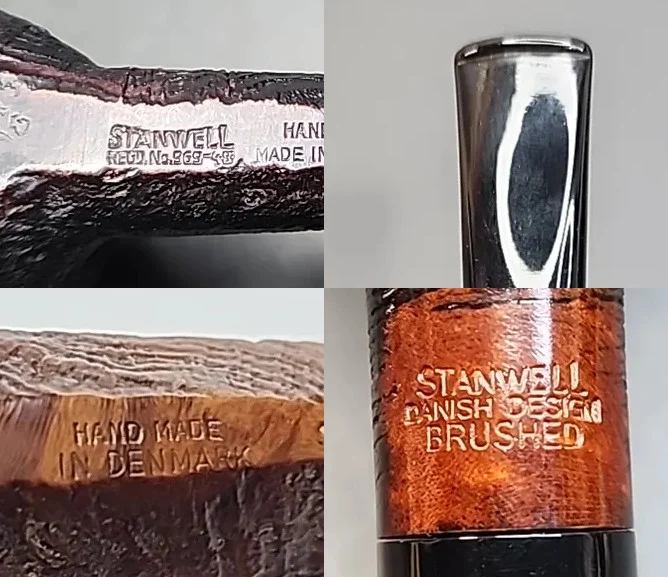
There are, however, other more resilient distinguishing properties of Stanwell pipes that can be tied to events in the make’s history. As for these properties, four are commonly considered to be the most pertinent:
- The stamp, ‘REGD. No. 969-48’.
- The material the pipe’s stem is made from.
- A ‘Denmark’ country of manufacture stamp (hereafter, ‘COM stamp’).
- The stamp, ‘DANISH DESIGN’.
As for events, thanks to the efforts of Stanwell collectors, testimonies from former Stanwell employees, and press releases from the Stanwell company itself, it is commonly accepted that:
- Stanwell began stamping its pipes with the make’s trademark registration number, 969-48, in 1948, and stopped this practice around 1970;
- Stanwell pipe stems were made from hard rubber (commonly known as ebonite) from the make’s inception until the 1990s, after which hard acrylic was used;
- Stanwell ceased producing its pipes in Denmark at the very end of 2009, after which production was moved to Italy, where it resumed in 2010.
Using this information, the manufacture of Stanwell pipes has been divided into four historical periods, or ‘eras,’ and a method for identifying pipes from these eras has been devised. As already mentioned, these eras are:
- 1948 – 1970;
- 1970 – 1990;
- 1990 – 2009, and;
- 2010 – present.
The method for identifying pipes from these eras can be summarized as follows:
- Pipes made between 1948 and 1970 feature the stamp, ‘REGD. No. 969-48’, ‘a ‘Denmark’ COM stamp, (e.g., ‘MADE IN DENMARK’, ‘HAND MADE IN DENMARK’, ‘DENMARK’ etc.), and have ebonite stems. These pipes are also often called ‘Reg. era,’ or ‘Registration era.’
- Pipes made between 1970 and the 1990s do not feature the bowl stamp, ‘REGD. No. 969-48’, but do feature a ‘Denmark’ COM stamp, and have ebonite stems.
- Pipes made between the 1990s and 2009 do not feature the bowl stamp, ‘REGD. No. 969-48’, do feature a ‘Denmark’ COM stamp, and have acrylic stems.
- Pipes made in 2010 and after do not feature the bowl stamp, ‘REGD. No. 969-48’, do not feature ‘MADE IN DENMARK’, but do feature the stamp, ‘DANISH DESIGN’, and have acrylic stems.
Another way of expressing this periodization and identification system would be the following table:

This is not the end of the story for dating Stanwell pipes. But, for the moment, let us recall what was said about the reasoning for dividing Stanwell manufacture in this way. The first era is differentiated from the second by the presence or absence of a registered trademark stamp; the second era is differentiated from the third by way of two alternative stem materials; and the third era is differentiated from the fourth by a stamp indicating a pipe’s country of manufacture. The question we may wonder, is why these eras have been chosen and not others. We may guess that the first and second eras are set apart because pipes that are older tend to be more valuable than pipes that are newer; we may guess that the second and third eras are similarly set apart because some pipe smokers prefer ebonite over acrylic; and we may also guess that the third and fourth eras are set apart because some pipe smokers may prefer that pipes from a quintessentially Danish make such as Stanwell be ones made in Denmark itself. These would be sensible guesses. But then why not distinguish between 1950s pipes and 1960s ones? After all, the former are older than the latter. Or, why not distinguish between pipes made in Stanwell’s first factory, based in Kyringe (where Stanwell began) and pipes made in the arguably more iconic Borup factory (where Stanwell pipes were made from 1969-2009)? For some pipes this may be possible; for others, it may not. But it would also certainly be a more difficult and less consistent approach.
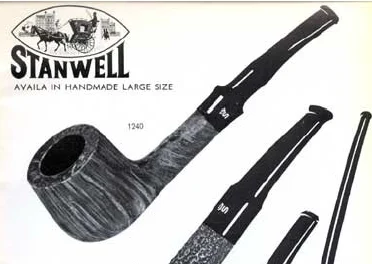
For example, Stanwell pipes originally had three- or, for certain series, four-digit model codes. The last two digits indicated the shape, and the first indicated the finish (for three-digit codes) or the finish and series (for four-digit codes). This was standard practice until some time in the late 1950s. After the 1950s, this numbering system was truncated so that only the shape code was stamped on the pipe. We might, consequently, wish to use this fact to establish a boundary between mid-1940s to late-1950s Stanwells and those that came after. The problem with doing so, however, is that three-digit codes would soon return, albeit in different forms. Special lines delineated by a three-digit shape code, such as the Design Choice, appeared decades after the original three-digit system; furthermore, as Stanwell expanded their range in subsequent decades, the number of shapes in their running catalog passed the 100 mark, meaning many Stanwell pipes now had three-digit numbers stamped on them purely by dint of being the 101st, 102nd, 103rd, shape, and so on. Those who were interested in dating Stanwell pipes could no longer use the number of digits stamped on a model as a hard and fast rule for separating periods of manufacture. One needed to also be acutely familiar with the history of Stanwell shapes, which takes a great deal of research, and whose fruits would render a dating guide more or less obsolete. As was said at the beginning: truth, value, and practicality are ever intertwined. For now, let us return to the question of ‘eras.’
A Five-and-a-Half-Era Approach
The Four Era approach outlined above is, in principle, a good general approach, or heuristic, for dating Stanwell pipes. As will be discussed later, there are plenty of exceptions to the rules it uses that have to instead be handled on a case-by-case basis, but most of the time, it should, in principle, work. Unfortunately, even as a general approach, it is inherently misleading and, on one very important detail, simply incorrect. But, as the ‘eras’ heuristic is useful, and as it has become so thoroughly ingrained within contemporary pipe culture, it may be better not to throw the baby out with the bathwater.
Extending the ‘Registration Era’
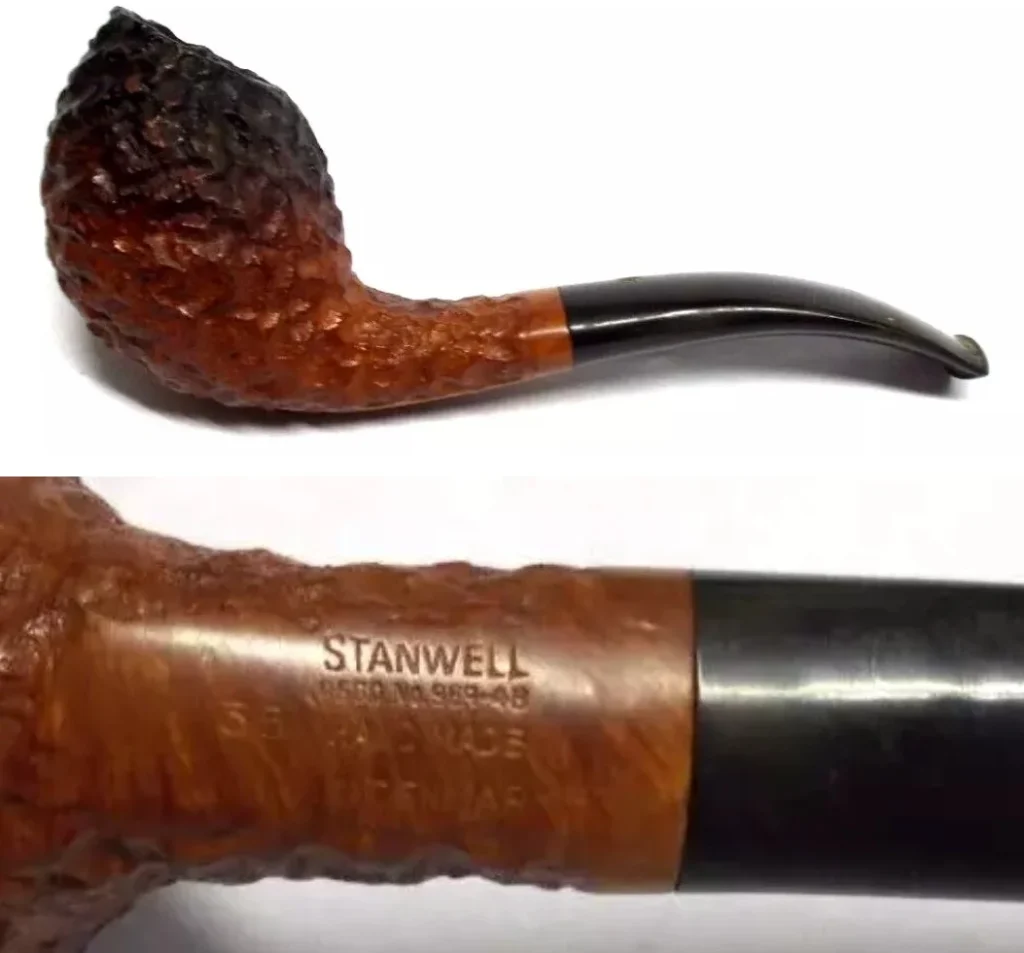
So, how do we go about fixing this, without scrapping Stanwell dating models entirely? To start with, the ‘Registration era’ did not end around 1970, as is commonly accepted. Instead, it is far more likely that Stanwell retired the ‘REGD. No. 969-48’ stamp at the very end of the 1970s. It is said that Stanwell was somewhat inconsistent in their usage of this stamp; nevertheless, there are good reasons to bring us to the conclusion that the cut-off point for the stamp’s usage was approximately a decade later than has been assumed.
The first is that numerous examples exist of Stanwell pipes designed by Anne Julie – such as the ’26’ bent Dublin and the ’35’ bent egg -with the Stanwell registration number stamped on them. For those who do not know, Anne Julie is one of the most celebrated Danish pipe-makers. She has also collaborated with Stanwell to design several of their pipe shapes. But Anne Julie did not even begin making pipes until after her husband, the similarly renowned pipe-maker Poul Rasmussen, unexpectedly passed away in 1967. To give a precise example, Stanwell’s shape ’35’ bent egg, designed by Anne Julie, did not debut until 1975. This comes from the Stanwell company’s own promotional materials for their collaborations with Danish pipe-making icons, such as the 50th Jubilee pamphlet below.
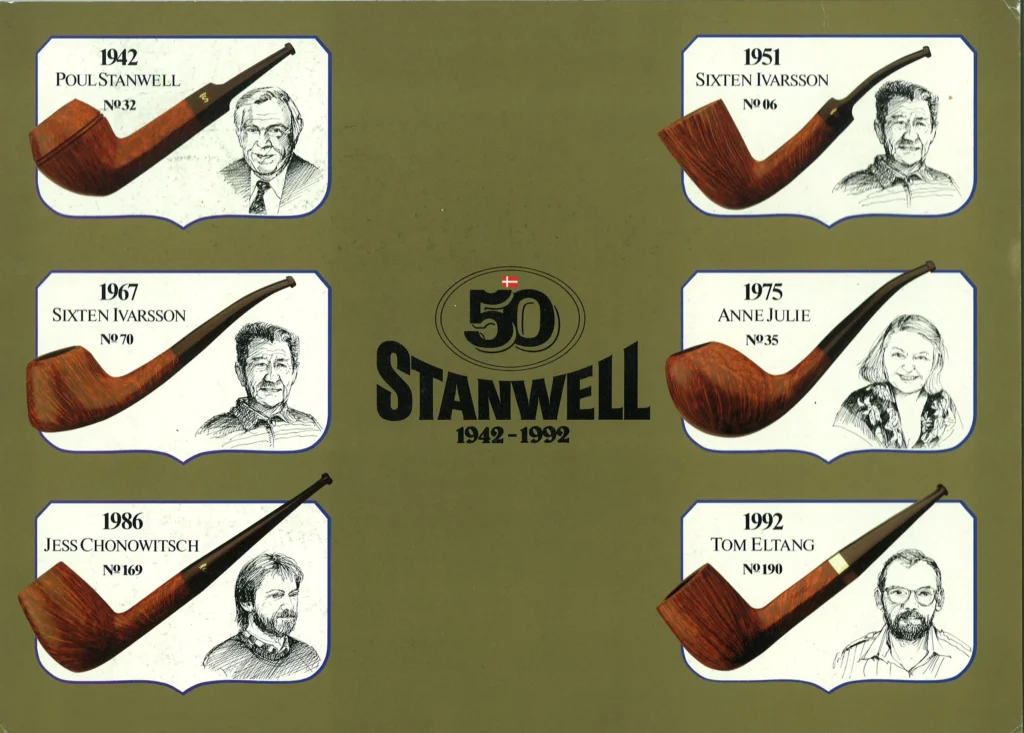
The second reason for adjusting the length of the ‘Registration Era’ is Stanwell’s Pipe of the Year from 1979. This was Stanwell’s very first Pipe of the Year, and is one that is frequently misidentified and inaccurately dated. It is a simple ‘dress pipe,’ i.e., a billiard stained in a dark, almost black hue, with a black ebonite stem and a silver collar. The pipe features the registration number stamp and has ‘1979’ engraved on its silverwork (pictured). With this in mind, the question to ask is whether Stanwell had already retired the registration number stamp at this point and simply stamped the 1979 PotY as a one-off, or whether the presence of the stamp evinces that it was still used as standard when this particular pipe was manufactured. We should also note that the stamp in question is absent from the 1980 PotY.
The former could reasonably be written off as a one-time thing, given the nature of the pipe and the placement of the registration number. Yet a second Stanwell model, again attributable to 1979 and featuring the registration number stamp, has recently been unearthed. This is the ‘Jubilee 1979’ pipe, not to be confused with the decennial models (1982, 1992, etc.). When I say “attributable,” I mean by virtue of what is what is stamped on the pipe, in much the same fashion as any other registration era model: “STANWELL”, “REGD No. 969-48”, “Jubilee”, “1979”. What does this 1979 Jubilee celebrate? That I do not know. Perhaps it was a celebration of ten years having passed since the opening of the Borup factory in 1969. Whatever the occasion, I find this to be compelling enough to place the end of the registration era closer to 1980 than 1970.
Stanwell Before STANWELL
The next step to take is to incorporate a lesser-known omission in the four-era approach, that being Stanwell pipes manufactured before 1948. For its anniversaries, the Stanwell company likes to backdate its origin to 1942, when Nielsen and his colleagues began manufacturing pipes, despite these pipes being the ‘Kyringe’ make. The ‘Stanwell’ make, however, was not debuted in 1948, but rather in 1945, while 1948 was the year the Stanwell trademark was formally registered. Because of this, there exist ‘pre-registration’ Stanwell pipes, i.e., Stanwell pipes manufactured before a trademark was registered. These pipes might otherwise be mistaken for post-registration era pipes, if not for the nomenclature on the former. Instead of the block-letter ‘STANWELL’ trademark, pre-registration era pipes have the Stanwell name rendered in a cursive, italicized script. Such pipes may sometimes also have animal horn stems, something that continued, it seems, only for a short period into the “Registration Era” (horn would, of course, be used elsewhere in later pipes, such as for ferrules).
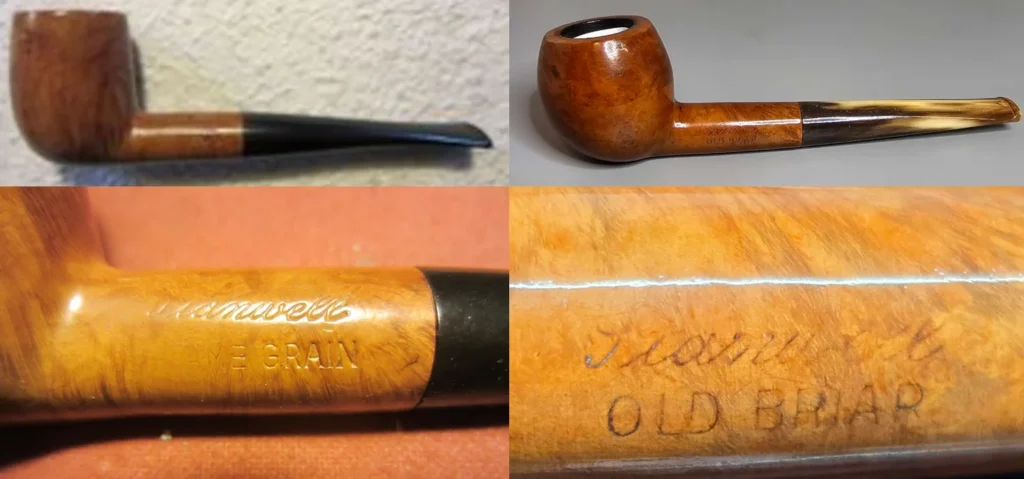
The Golden Dot
A last (for now) correction or, rather, ‘calibration,’ to be applied to the Stanwell dating system concerns the transition from the use of ebonite to acrylic for Stanwell stems. It would be a mistake to assume, for example, that a Stanwell pipe with an ebonite stem must be pre-1990s; inversely, it would be too imprecise to assume that a Stanwell with an acrylic stem was made from any time after 1990. This is because it was not until approximately 1994 that Stanwell began using acrylic, and only did so for some pipes (the 9mm variant of the 1994 Pipe of the Year being the earliest example I have yet found). These early acrylic-stem models were typically sold for the German market and can be identified by a gold dot next to the ‘S’ logo on their stem. Furthermore, it seems that it was not until around 1998 that Stanwell began using acrylic as standard. While the non-filter variant of the 1998 Pipe of the Year featured a vulcanite stem, slow smoking competition pipes, including the one supplied for the 1998 Danish Championship, featured acrylic stems. In the case of the latter, the golden, crowned “S” logo was present on the stem, but the dot was not. Both the non-filter and filter variants of the 1999 Pipe of the Year featured acrylic stems, again minus the gold dot.
If we factor these amendments into a new set of periods and identifiers, we end up with something like the following:
A Revised Dating System for Stanwell Pipes
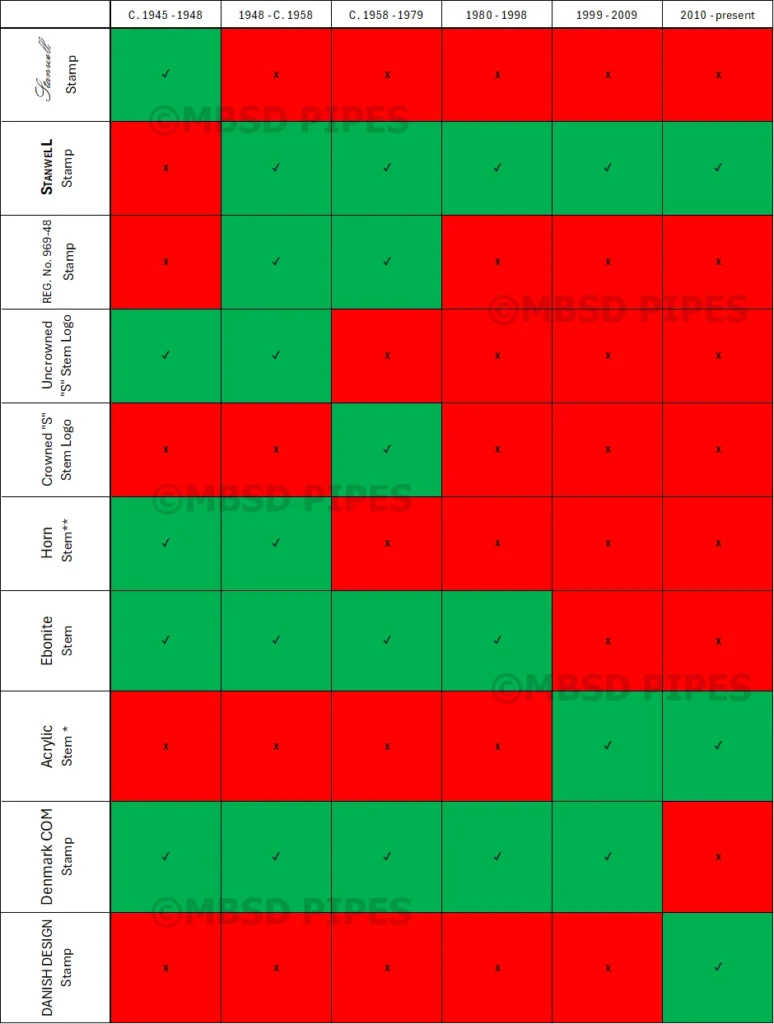
** It is unclear whether horn stems were stamped with the Stanwell “S” logo in either of its basic forms.
This would be a five-era system, rather than the typical four-era one – or, rather, it would be a five-and-a-half-era due to the 1995-1998 period where both ebonite and acrylic were used in the manufacture of Stanwell stems. But this creates two problems: one, because a system that divides manufacture into discrete eras should not have any overlap between these eras, and; two, identifiers ideally should be as exclusive as possible. Regarding the former, adding a separate era for the 1994-1998 period would create such an overlap; regarding the latter, adding a separate ‘Ebonite OR Horn Stem’ cell for 1945-1948 pipes opens the door to questions such as of why we should not also include an ‘Ebonite OR Acrylic Stem’ category for the 1975-1998 period. But this would, in turn, undermine the now-established distinction between 1975-1998 and 1998-2009 pipes. It would be more practical and less complicated to accommodate 1994-1998 acrylic stem pipes with a simple caveat (hence the ‘*’), and to allow for just the one inclusive disjunction when it comes to 1945-1948 stems.
We should now be able to see that, despite the majority of them not being stamped with their year of manufacture, Stanwell pipes can still be dated, albeit to fairly broad periods in the make’s history. Unfortunately, this is not all that is left to say. There are, instead, exceptional pipes that even our revised dating system would struggle to accommodate.
Exceptions to the Rule: A Selection of Examples
It would be fair to estimate that, in most instances, if a random Stanwell pipe fell into our lap, we would be able to correctly date it using the system outlined above. However, given that Stanwell has, the history of the company thus far, already manufactured millions of pipes, being correct even 90% of the time would still entail an extraordinary number of incorrect judgments. These would not need to be rooted in mistaken formulations or applications of our system, either. The problem here is not user error, nor is it necessarily the knowledge embedded in the system; rather, the problem has to do with the essential properties of any such system.
Any dating system rests on the presumption that the coherence of its categories and the consistency of its methods are mirrored in the objects it is supposed to apply to. In other words, it is a set of rules should, in theory, map neatly onto another set of rules, those being the ones followed (consciously or otherwise) in the production of said objects. In the case of Stanwell, these are rules that allow pipe historians, collectors, buyers, and sellers to confidently distinguish between large sets of pipes and to act upon them accordingly. But this only works because the Stanwell company itself is presumed to have followed functionally equivalent rules when manufacturing Stanwell pipes. But what happens when Stanwell ‘breaks’ these rules?
Throughout its history, the Stanwell company has produced pipes that do not conform to the rules it has otherwise quite strictly followed. It has done this not once or twice, but many times. These are not improperly manufactured pipes that have somehow escaped quality control; they are not pipes from Stanwell’s many historical sub-brands; and they are not complete breaks, with a set of new, consistent conventions (such as dropping the registration number) subsequently established. While there will inevitably be some Stanwell pipes that exist due to mistakes, such as stamping errors, during production, our concern here are deviations from the norm that were entirely intentional. The latter are official series of main-line Stanwell pipes and these series are numerous. A whole book could probably be written on the difficulties of dating such pipes, but for now I will close this guide by instead simply listing a few significent examples of them and, where possible, locate them within the dating system outlined above.
- The ‘Pipe of the Year’ for 1979. This is a dress (black) finish pipe bearing the typical ‘Stanwell’ nomenclature, the registration number (969-48), and a silver band engraved with the number ‘1979,’ with an ebonite stem. This was Stanwell’s first Pipe of the Year, produced in 1979. As mentioned previously, it may be the only post-registration era Stanwell model to date that features its trademark registration number; regardless, prior miscalculations about the length of this era have led to plenty of confusion as to its provenance. Admittedly, this pipe is not an ‘exception’ in essence, but rather an exceptional pipe due to the trouble it causes for the common Four-Era system. Within the ‘Five-and-a-Half Eras’ system these pipes would therefore be classified as belonging to the 1948-c.1979 period.
- Tom Eltang’s Sales Tour Pipes. These pipes bear the ‘Stanwell’ nomenclature but no other stamping aside from the letters ‘TE’ in a circle, and have ebonite stems. These pipes were produced circa 1980 and came about as a result of Tom Eltang’s role as a brand ambassador for Stanwell. Eltang would pick up half-completed stummels from the Borup Stanwell factory and finish them in his own workshop or while on the road, adding his initials to the pipe during the process. 1980-1998.
- Poul Winsløw’s Sales Tour Pipes. In the late 1980s and 1990s, Poul Winsløw took on a traveling brand ambassador role taken by Tom Eltang in the early 1980s. Winsløw’s pipes are quite different to Eltang’s however, partly because he performed this role for longer than Eltang, and partly because he had his own approach to making these pipes. First, the stamping: these pipes may be stamped with the familiar ‘Stanwell’ nomenclature, along with an arched script, reading ‘POUL WINSLØW/HAND CUT/PIPES/DENMARK’, or they may simply be stamped with the ‘Stanwell’ nomenclature and ‘WINSLØW.’ The former are earlier pipes from the late-1980s to early-1990s, while the latter coincide with Stanwell’s forays into acrylic stems in the mid- to late- 1990s. As such, the former have ebonite stems, while the latter may have ebonite or acrylic stems, and the use of acrylic may be accompanied by a gold dot next to the stem logo, as was convention for the time. Perhaps the most curious things about Winsløw’s sales tour pipes are that he made many of these pipes at exhibitions, while visitors watched, and that many of these pipes were Winsløw’s idiosyncratic interpretation of shapes from the Stanwell catalog. This means that, while the pipes Winsløw made for Stanwell are technically all Stanwell shapes from the period, their designs can nevertheless deviate quite significantly from the ‘same’ shapes as made in Stanwell’s factory. On a last note, some of these pipes have letters stamped on them. Winsløw offered buyers of the pipes he made in public to have their initials on the pipe, which these letters represent. 1980-1998, with the possibility of some early 1998-2009 manufactures.
- ‘Hand Cut’ Series Pipes. These pipes are minimally stamped, with only the Stanwell trademark, a Denmark COM, and occasionally a shape number on the briar, and a block-letter ‘HAND CUT’ stamp in white on the stem. Stanwell has sold ‘Hand Cut’ pipes since the early 1950s, however the term was originally used to separate Stanwell’s more ‘Danish’ shapes (which required greater degrees of hand-shaping) from their ‘Standard’ shapes (which were more traditionally inclined and manufactured). Stanwell also used a white, block-letter stamping of ‘HAND CUT’ on the stems of some of its pipes around the 1960s and 1970s. In the second half of the 1980s, however, Stanwell offered a limited run of pipes under the series name, ‘Hand Cut.’ These were pipes whose stems were, as the name suggests, hand cut, purportedly by Danish master pipe-makers in the surrounding area, such as Jess Chonowitsch and Tom Eltang. These stems were also typically cut from cumberland (red and black ebonite). Unfortunately, as with early Stanwell ‘S’ stem stamps, these ‘HAND CUT’ stamps have a tendency to wear off over time, and to complicate things further, the Hand Cut series is not the only cumberland-stem series Stanwell (such as the ‘Nordic’). 1980-1998.
- ‘Chess’ Series Pipes. Stanwell first began offering ‘Freehand’ pipes in the 1960s, with these pipes being Danish freehands as we would today use the term. These pipes were not stamped as ‘freehands’ but were marketed as such, and can be dated thanks to their registration number stamp. Several decades later, Stanwell created a new freehand series using chess pieces as a grading system. Freehand pipes with the ‘Stanwell’ nomenclature can therefore be found with the additional stamping of ‘ROOK,’ ‘BISHOP,’ ‘QUEEN,’ and ‘KING,’ signifying (ascending) grades. These pipes may also feature a Denmark COM stamp, but they also may not. As far as I have seen, all Chess pipe stems are acrylic. As some examples of these pipes exist with the gold dot stem stamp alongside the stanwell ‘S,’ production of these pipes likely began during the mid-1990s, but as most do not have this additional stamping, their manufacture likely ended some time before 2010. Poul Winsløw was originally charged with manufacturing the Chess series, and it is likely that pipes without a Denmark COM stamp are from his tenure. Stanwell later moved production of the series in-house. A few 1980-1998 manufactures, but mostly 1998-2009.
- ‘Poul Stanwell Collection’ Pipes. In the late 2000s, Stanwell began offering ‘Poul Stanwell Collection’ pipes, which were special editions of classic Stanwell shapes. This ‘collection’ was comprised of two series, one of standard bore (non-filter) pipes, and one of pipes with a 9mm bore for filter users. Both series can be found advertised in the 2009 Dan Pipe catalog. These pipes are stamped with the words, ‘POUL STANWELL COLLECTION’ and the original shape number, but nothing else. In the case of the German-market, 9mm bore Collection pipes, these remain in production, or have until very recently, making distinguishing Danish-made iterations from Italian-made ones very difficult, if not impossible. 1998-2009/2010-present.
- ‘Bamboo’ Pipes. Stanwell has produced smooth and sandblasted pipes with bamboo shank extensions since the 1950s, and continues to do so today (2024). Originally, the rationale behind using bamboo was to reduce the amount of briar needed to make a pipe, as the latter was scarce during and after the Second World War. Naturally, this also leaves little room for nomenclature, so the Stanwell name was stamped on the bamboo itself, as was the trademark registration number, but shape numbers and COM designations were omitted. After Stanwell stopped stamping this number on their pipes, only the Stanwell name remained. It is only recently (likely 2010 and post) that Stanwell has started stamping shape numbers onto the briar portion of their bamboo pipes. Consequently, dating bamboo pipes is a matter of noting whether a registration number is present on the bamboo (1948-c.1979), whether the stem is ebonite (1980-1998) or acrylic (1998-2009), and whether a shape number is present on the briar (2010-present). To avoid misidentifying Stanwell bamboo pipes, however, another series of pipes needs to be mentioned.
- 2008 Summer Olympics Bamboo Pipes. To celebrate the 2008 Summer Olympics, hosted in Beijing, and to cater to the growing number of pipe collectors in China, Stanwell offered a limited set of pipes for the Chinese market. These pipes are easily misrecognized for recent standard-production Bamboo pipes, as they are also pipes with bamboo shank extensions, onto which numbers are stamped. However, these pipes are distinguished by a smooth, black lacquered finish, rather than a light or dark brown stain. The numbering of these pipes is also distinct, taking the form of ‘No. 72’ (for example) rather than a standalone number. The number itself signifies which iteration of the limited set the pipe is, out of the 450 made. 1998-2009.
- ‘Nanna Ivarsson Design’ Pipes. Between 2009 and 2010, Stanwell debuted four new, limited release pipe shapes designed by Nanna Ivarsson. These pipes are stamped with the Stanwell trademark, ‘AN IVARSSON DESIGN’ (in a circle), and with a corresponding shape code. As these debuts coincided with the closure of Stanwell’s factory in Borup, Denmark at the end of 2009, and the move of the make’s production to Italy at the beginning of 2020, two of the Nanna Ivarsson shapes were manufactured in Denmark and two were manufactured in Italy. As such, shapes ‘N1’ and ‘N2’ also have a Denmark COM stamp, whereas shapes ‘N3’ and ‘N4’ do not. 1998-2009 for the former, early 2010-present for the latter.
Concluding Remarks
This guide is not intended to be the last word on dating Stanwell pipes. Unlike many other historic makes, Stanwell continues to manufacture pipes, with no sign of stopping anytime soon. I would also welcome suggestions for breaking up the 1948-c.1979 registration era, as it is currently by far the longest period in the dating system provided. In other words, it is likely that there are more ‘eras’ on the horizon. I would therefore be very open to someone coming up with a dating system that is more extensive than the one outlined here – one that can exhaustively process ‘normal’ and ‘exceptional’ pipes alike, reduce the time-span of the registration Era, and that is nevertheless simple and usable for novices, enthusiasts, and the most die-hard Stanwell aficionados. It may even be the case that a secondary system solely for differentiating registration Era – provided that they are first correctly identified as belonging to that period – pipes would be a worthwhile addition to our Stanwell knowledge. Until then, I hope this guide serves its intended purposes.
We hope you’ve found this guide helpful for understanding how Stanwell pipes can be dated. If you liked the guide, or if there’s anything you think we’ve missed, we’d love to hear from you in the comments or by using our contact form. MBSD frequently has Stanwell pipes from each of its various periods and places of manufacture, including rare and exceptional pieces. You can find some of these pipes by clicking the link here, or you can contact us to ask if we have any that will be on the website in the near future.
Lastly, if you have a Stanwell that you would like to sell or to trade in for MBSD store credit, we would love to hear from you, which you can do by using the contact form linked above.

